Dear Zazie,
Here is today’s Lovers’ Chronicle from Mac Tag. Perhaps, the most meaningful, important TLC post.
The Lovers’ Chronicle
Dear Muse,
© copyright 2021 mac tag/cowboy coleridge all rights reserved
© copyright 2020 mac tag/cowboy coleridge all rights reserved
that allows just enough
space for two abreast
can you hear
now, the music
from the beginnin’
the circle
of the past
has been broken
at last
chances traveled on,
voices in accord,
lead us here
the proof of what
and to what end
within our grasp
© copyright 2019 mac tag/cowboy coleridge all rights reserved
time runnin’ out
nothin’ new there
seems to help
though you might best
judge that
i know
keep comin’ back
to the same thing
but you tell me,
how can i not
when the only possible
thing that can ever matter
is becomin’ half of a whole
© copyright 2018 mac tag/cowboy coleridge all rights reserved
lost
do not know or cannot find
a way to attest to existence
a matter of faith
or the lack thereof
a form of seduction
a chosen solitude
rather than a prescribed future
eventually become ordinary
in time and fade in obscurity
if only…
lovers
a chance to be a part
of the only thing that matters,
time transients escapin’
the problems posed
by daily existence
speak the language
heroes
© copyright 2017 mac tag/cowboy Coleridge all rights reserved
| Statius | |
|---|---|
 |
|
Today is the traditional day to celebrate the birth of Publius Papinius Statius (Naples; c. 45 – c. 96 AD Naples); Roman poet of the 1st century AD (Silver Age of Latin literature). His surviving Latin poetry includes an epic in twelve books, the Thebaid; a collection of occasional poetry, the Silvae; and an unfinished epic, the Achilleid. He is also known for his appearance as a guide in the Purgatory section of Dante’s epic poem The Divine Comedy.
Verse
Exedere animum dolor iraque demens
et, qua non gravior mortalibus addita curis,
spes, ubi longa venit.
Statius
- Grief and mad wrath devoured his soul, and hope, heaviest of mortal cares when long deferred.
Nec frons triste rigens nimiusque in moribus horror
sed simplex hilarisque fides et mixta pudori
gratia.
Statius
- Yet no stiff and frowning face was hers, no undue austerity in her manners, but gay and simple loyalty, charm blended with modesty.
Today is the birthday of Jan van Beers (Jean Marie Constantin Joseph van Beers; Lier 27 March 1852 – 17 November 1927 Fay-aux-Loges); painter and illustrator, the son of the poet Jan van Beers. They are sometimes referred to as Jan van Beers the elder and Jan van Beers the younger. In 1884, Jan Van Beers produced the pen-and-ink sketches for the edition de luxe of his father’s poetry.
In 1880 he moved to Paris and immediately abandoned historical pictures, producing instead genre and portrait works of the middle classes and developing a successful line in attractive draped young ladies reading a letter or a book or day-dreaming about a lover. Van Beers said that he wanted to paint what he saw and that the best and most interesting things that one saw in Paris were her women.
Gallery

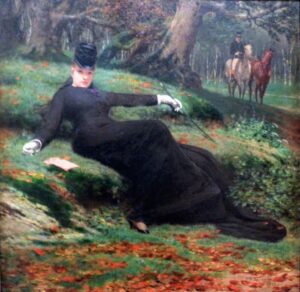

in his studio, Paris, late 1880s
|
|

An 1891 Vanity Fair caricature of Van Beers titled “The Modern Wiertz”

-

A balcony, undated
-

The letter, 1885
-

Portrait of a young woman, 1883
-

With thoughts of him, undated
-

In the hammock, undated
-

Portrait of a noble woman, 1880s
-
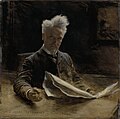
Henri Rochefort, undated.
-

Portrait of a man, undated. Possibly Franz von Wertheim, Jr.
-

When stars set
-

Boy with hummingbird
-

Souvenance
-

The melon seller
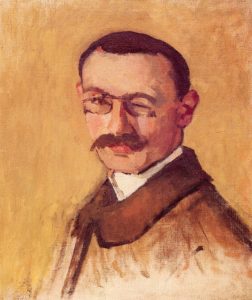 Today is the birthday of Albert Marquet (Bordeaux 27 March 1875 – 14 June 1947 La Frette-sur-Seine, Val-d’Oise); painter, associated with the Fauvist movement. He initially became one of the Fauve painters and a lifelong friend of Henri Matisse. Marquet subsequently painted in a more naturalistic style, primarily landscapes, but also several portraits and, between 1910 and 1914, several female nude paintings.
Today is the birthday of Albert Marquet (Bordeaux 27 March 1875 – 14 June 1947 La Frette-sur-Seine, Val-d’Oise); painter, associated with the Fauvist movement. He initially became one of the Fauve painters and a lifelong friend of Henri Matisse. Marquet subsequently painted in a more naturalistic style, primarily landscapes, but also several portraits and, between 1910 and 1914, several female nude paintings.
Gallery
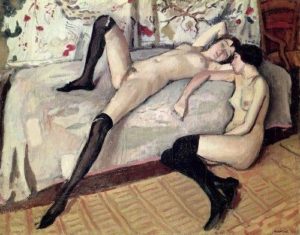
Les deux amies


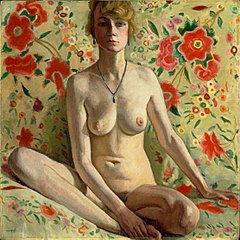
| Edward Steichen | |
|---|---|

Edward Steichen, photographed by
Fred Holland Day (1901) |
|
And today is the birthday of Edward Jean Steichen (Bivange/Béiweng; March 27, 1879 – March 25, 1973 West Redding, Connecticut); photographer, painter, and art gallery and museum curator. Steichen was the most frequently featured photographer in Alfred Stieglitz’ groundbreaking magazine Camera Work during its run from 1903 to 1917. Together Stieglitz and Steichen opened the Little Galleries of the Photo-Secession, which eventually became known as 291 after its address.
His photos of gowns for the magazine Art et Décoration in 1911 are regarded as the first modern fashion photograph. From 1923 to 1938, Steichen was a photographer for the Condé Nast magazines Vogue and Vanity Fair while also working for many advertising agencies including J. Walter Thompson. During these years, Steichen was regarded as the best known and highest paid photographer in the world. In 1944, he directed the war documentary The Fighting Lady, which won the 1945 Academy Award for Best Documentary.
After World War II, Steichen was Director of the Department of Photography at New York’s Museum of Modern Art until 1962. While at MoMA, he curated and assembled the exhibit The Family of Man, which was seen by nine million people.
Steichen married Clara Smith in 1903. In 1914, Clara accused her husband of having an affair with artist Marion H. Beckett, who was staying with them in France. The Steichens left France just ahead of invading German troops. In 1915, Clara Steichen returned to France with her daughter, staying in their house in the Marne in spite of the war. Steichen returned to France with the Photography Division of the American Army Signal Corps in 1917, whereupon Clara returned to the United States. In 1919, Clara Steichen sued Marion Beckett for having an affair with her husband, but was unable to prove her claims. Clara and Steichen eventually divorced in 1922. Steichen married Dana Desboro Glover in 1923. She died of leukemia in 1957. In 1960, aged 80, Steichen married Joanna Taub and remained married to her until his death, which occurred two days before his 94th birthday. Joanna Steichen died on July 24, 2010, in Montauk, New York, aged 77.
Gallery
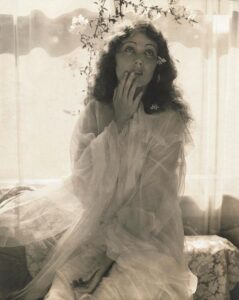
Fay Wray posing as Ophelia for Vanity Fair 1930



-

Landscape with Avenue of Trees, a painting, 1902
-

Portrait of Auguste Rodin by Steichen, 1902
-

The cover of Camera Work, showing Steichen’s design and custom typeface. Also, in this specific issue, Issue 2, the entire volume was devoted to Steichen’s photographs.
-

Self-portrait. Published in Camera Work No 2, 1903
-

Portrait of J.P. Morgan, taken in 1903
-

The Flatiron Building in a photograph of 1904.
-

Experiment in Three-Color Photography, published in Camera Work No 15, 1906
-

Pastoral – Moonlight, published in Camera Work No 20, 1907
-
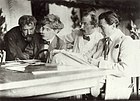
Eugene, Stieglitz, Kühn and Steichen Admiring the Work of Eugene, by Frank Eugene from 1907. From left to right are Eugene, Alfred Stieglitz, Heinrich Kühn, and Steichen.
-
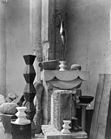
Picture of Brâncuși’s studio, 1920
-

Portrait of Constantin Brâncuși, taken at Steichen’s home & studio at Voulangis, in 1922.
-

Wind Fire. Thérèse Duncan, the adopted daughter of Isadora Duncan, dancing at the Acropolis of Athens, 1921
-

Isadora Duncan in the Parthenon, Athens, 1921
Mac Tag

No Comments on "The Lovers’ Chronicle 27 March – attest – verse by Statius – art by Jan van Beers & Albert Marquet – photography by Edward Steichen"